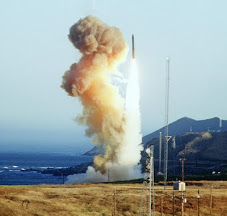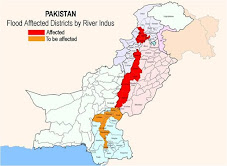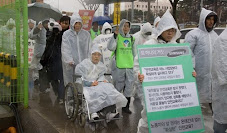*
Text fwd from Martha Duenas on May 14, 2011
http://www.dispatchjapan.com/blog/Pressure Builds for US Shift on Okinawa
Pressure is growing on the Obama Administration to significantly alter plans for US Marine basing arrangements on Okinawa, but chances seem slim for a policy shift at least until Defense Secretary Robert Gates departs office late next month.
Several factors have converged to give the issue new urgency. Opposition remains strong on Okinawa to construction of a new facility in the Henoko Bay area, to replace the US Marine Air Station Futenma, which has been slated for closure since 1995. There is simply no momentum in Japan to move forward with the project, a situation made more stark by the Great Eastern Earthquake of March 11. Tokyo is intensely focused on reconstruction efforts; neither the financial nor political capital is available to push the Henoko project through.
Meanwhile, construction delays and cost overruns continue to bedevil a critical, related portion of the plan: the relocation of over 8,000 Marines and 9,000 family members from Okinawa to Guam.
And in Washington, an increasingly debt-weary Congress is asking whether it is worth the cost of building the new Henoko facility and the new Marine housing and related facilities on Guam, when cheaper force configurations more conducive to strategic needs in Asia might be found.
Diplomats are under stress to find some answers because of plans for a “2+2” meeting of defense and foreign ministers from the two countries, to be followed by a summit meeting between President Barack Obama and Prime Minister Naoto Kan. With leaders in Japan tied down with reconstruction efforts, no schedule has yet been set for either meeting, though staging both by the end of June has been discussed.
When those meetings do occur, it won’t be possible to simply ignore Futenma and related Okinawa issues. It is very possible Washington and Tokyo will agree to state the obvious: the 2014 deadline to complete the Okinawa and Guam force structure realignment will have to be pushed back. It is also possible the administration will accept a very low-key statement of continued support for the Henoko plan, rather than a high-profile emphasis, so as to avoid the issue returning as a major irritant at the top of the bilateral agenda.
There remain pockets of hope within the Obama administration that White House will force the Pentagon to accept a review of the whole base realignment plan for Okinawa prior to the Obama-Kan summit, but that seems very unlikely.
PENTAGON BOTTLENECK: Secretary Gates remains adamantly opposed, and there does not yet exist within the administration the necessary correlation of political forces willing to force Gates to accept a new approach. The Pentagon’s rigid stance is worsened by the lack of a replacement yet for General Chip Gregson, who retired recently as assistant secretary of defense for Asian affairs.
Senior Pentagon officials continue to say the administration is committed to the Henoko plan. But with the Pentagon leadership in transition, with CIA director Leon Panetta set to take over once Gates departs, the senior officials are exceedingly reluctant to veer from established policy, even if they want to. Officials at this level are in a bind: aware of the opposition in Japan, aware of the enormous investment the US Marines, and US diplomacy, have in the existing policy, but not politically strong enough to even push for, much less win, a policy change.
AWAITING LIPPERT: The White House has tapped Obama confidante Mark Lippert to replace Gregson, but Lippert has been bruised a bit as he works his way through the administration’s internal political gauntlet. Some Pentagon officials have quietly raised concerns that Lippert might have the kind of strained relations with senior military officers that could hinder his effectiveness.
Lippert, who has served in Iraq as a Navy intelligence officer, is “pro-military,” and is known to have functioned as a bit of a window into the US armed forces for then-Senator and presidential candidate Barack Obama. But Lippert is not “pro-Pentagon.” Lippert is an international relations major from Stanford University who has served in the military with pride, but is committed to the military as a tool of policy, not out of institutional loyalty. His loyalty is to Obama.
For much of Obama’s first year in office, Lippert served as chief of staff for the National Security Council (NSC). He clashed with General Douglas Lute, a holdover from the Bush administration as “war czar” for Iraq and Afghanistan. He also had tense relations with his nominal boss, then-National Security Advisor General Jim Jones. Critics say Lippert flaunted his close relationship with Obama. But the close tie with Obama is real, and strong, and Obama personally would like to see Lippert overseeing Asia policy for the Pentagon. That is still likely to happen, though those harboring reservations could trip him up.
ASIA POLICY SHIFT: Evidence continues to grow that President Obama and his top aides would like to see a major US strategic shift toward greater emphasis on Asia, which should be particularly evident when the President hosts the APEC summit in Hawaii next November.
It’s notable that in a recent New Yorker analysis of Obama’s foreign policy, NSC director Tom Donilon, deputy director Ben Rhodes (Obama’s long-time chief foreign policy speechwriter), and Assistant Secretary of State for East Asia Kurt Campbell were all quoted outlining just such a strategic “rebalancing” of American foreign policy. The Pentagon’s top policy chief, Michelle Flournoy, outlined a similar policy in a recent talk at Johns Hopkins.
The administration is looking to energize America’s role in East Asia by fomenting a system of open and transparent economic and security cooperation in the region, defining the terms of engagement to which China has to respond. The economic component, for now, is the Trans-Pacific Partnership regional trade initiative. And the security component involves building on America’s traditional bilateral security alliances in the region to include a network of overlapping bilateral, trilateral, and multilateral security relationships from India, through Vietnam and Indonesia, to Australia, and up to Korea and Japan.
Japan is already cultivating security ties with India and Vietnam, and deepening ties with South Korea, including discussion of formal military agreements involving information sharing and the exchange of military goods and services. China and South Korea both provided relief assistance to Japan after March 11, opening the door to expansion of the existing “Plus Three” dialogue between Tokyo, Seoul, and Beijing.
Washington is supportive of these steps by Japan, as they indirectly extend the influence of the US-Japan alliance, while providing Tokyo a far greater degree of self-determination than possible through the exclusively bilateral US-Japan security alliance.
THE FUTENMA DILEMMA: The problem Washington faces is that continued focus on the Futenma dispute threatens to distract the US and Japan from this broader strategic goal, allowing a relatively minor base dispute to disrupt the whole alliance. Excess focus on Futenma also detracts from the absolutely critical role played by the naval facility at Yokosuka, where the US home ports the USS George Washington carrier group, and the role of the huge Kadena Air Force base on Okinawa. Together, Kadena and Yokosuka allow the US to project enormous power throughout East Asia, and are the principle means to deter North Korean aggression, and to balance China’s rising military role in the region.
Tokyo continues to insist Japan fully backs the plan for a new facility at Henoko, fearful that admitting the plan is dead will cause tension with Washington. And Washington continues to back the Henoko plan, because no political decision has been made to abandon the bureaucratic status quo.
With no decision yet made to abandon the Henoko project, none of the necessary talks about a new plan can proceed. That leaves the US-Japan alliance dangerously vulnerable to a crisis in the event of a helicopter crash at the Futenma facility, which is surrounded by civilian communities.
CONGRESSIONAL INTRIGUE: Into this bureaucratic quagmire have stepped three senior and very influential US senators: Carl Levin, Chairman of the Armed Services Committee; John McCain, the Ranking Republican on Armed Services; and, Jim Webb, chairman of the Asia subcommittee of Senate Foreign Relations. On May 13, the three senators issued a joint statement calling for the Defense Department to “re-examine plans to restructure U.S. military forces in East Asia.” The senators said the US “strongly supports a continuous and vigorous US presence in the region,” but emphasized that they “believe the current DoD realignment plans are unrealistic, unworkable, and unaffordable.”
While the statement was “joint,” Senator Levin seemed to emphasize the need for restraint, and cost-effectiveness, in defense spending, especially in the construction of new overseas facilities. Senator McCain tended to emphasize strategy, saying: “The Asia-Pacific region’s growing role in the global distribution of power requires us to consistently view and update plans for the U.S. military’s role in the region.” And Webb forcefully challenged the Marine Corps claims that construction of a new facility in Henoko Bay to replace the Futenma air station is indispensable to the Marine presence in, and thus the stability of, East Asia.
Webb brings to the issue years of experience as a Naval Academy graduate, a highly-decorated Marine officer, a military planner, a former Secretary of the Navy, and now almost a full term as a US senator.
With Webb taking the lead, the three senators proposed a dramatic overhaul of the US Marine presence in East Asia. The key elements would include: a) “abandonment” of the Henoko project at Camp Schwab as a replacement for the Futenma facility; b) integration of the Marine Corps assets at Futenma into Kadena Air Force base, while dispersing some Air Force assets now at Kadena to other areas of the Pacific; c) home-basing in Hawaii or at Camp Pendleton the 8,000 Marines now scheduled to redeploy to Guam, and deploy those Marines on a rotating basis throughout the Pacific.
THE JONES ROLE: Most intriguing is that retired Marine Corps General Jim Jones, who was President Obama’s national security advisor until last October, played an important role in helping Webb craft these proposals. It will be difficult for the current Marine Corps leadership to argue to legendary Marine veterans Jones and Webb that their proposals would be harmful to the Marine Corps, and are otherwise operationally unrealistic.
Jones first publicly revealed his apparently evolving views on Okinawa in a meeting last week with a group of Japanese parliamentarians, including former Chief Cabinet Secretary Yasuhisa Shiozaki (LDP) and Mikio Shimoji, policy research chief for the People’s New Party (PNP). According to Shiozaki and Shimoji, who met with reporters after their meeting with Jones and displayed their written notes, Jones said that he had always thought the best approach on Okinawa was to merge into the Kadena air base the Marine aircraft operations now based at Futenma. The Henoko project was not needed.
It remains unclear what, if anything, Jones did to try to change American policy toward Futenma while he was national security advisor.
THE SKEPTICAL VIEW: Some sources very close to the situation are skeptical that the Obama administration will shift Okinawa policy any time soon. According to this view, it makes sense that the administration would seek to kick the Futenma-Henoko issue down the road a while longer.
Pushing back the 2014 deadline would amount to acknowledging the obvious, and acknowledging the difficulties to proceed so soon after the March 11 natural disasters would also buy more time to find a permanent solution.
But Senator Webb is proposing a wholesale rethinking of American strategy and force structure in the Western Pacific, and only the Secretary of Defense and/or the President himself can make those kinds of decisions. Without that heavy push from the White House, according to this view, it would not be possible to shake the bureaucracy out of its policy rut.
From a strategy standpoint, opponents of a shift in Okinawa policy will argue that it would signal a US retreat from Asia, and reduce the American deterrence of China.
WORKING WITH CONGRESS: But the White House continues to send signals that it is serious about a shiftin strategy toward Asia. A restructured US force posture would not be seen as retreat, but rather an effective region-wide “hedge” in the event China tries to throw its growing weight around in the region. And sources close to Kurt Campbell say that he is convinced that continued US and Japanese wrangling over Futenma will threaten the whole “shift” strategy, because it can’t work without a vibrant US-Japan alliance.
Campbell is prepared to work with Webb and others in Congress on a new basing arrangement for the Marines in the Pacific. Once Panetta takes over as defense secretary, and assuming Lippert becomes his top deputy for Asia, the White House would have in place an administration-wide team to pursue an expanded role in the region.










































![[URGENT PLEA: In Update] EMERGENCY in GANGJEONG Since AUG. 24, 2011](https://blogger.googleusercontent.com/img/b/R29vZ2xl/AVvXsEiQvpaNf6EePZVucu97_JphYsFS5IgumnSiA4YAmen1PZcim6vMmW7XjZ7J6nLh-Cu36mwBN5n1evrA3ey0vYMpwlAGsgnSFggv6a1w4Qx9BvvqOB0hy0BIcBkL2Exfs3zIxBsBuDGa1kzg/s227/jejusit.jpg)



![[Solidarity from Japan for the Jeju] 253 individuals and 16 groups/organizations](https://blogger.googleusercontent.com/img/b/R29vZ2xl/AVvXsEivji7100kBkr0hzvqYfh4IBBilkZ6XgDIg89jOxS6kTssxsVKC6Wm-fZbKOEsiy3zcO-9gW6GHspD5R_2C9WsGx5S1Z5VPj_OVRF7H6dxdaT0S-2H1eqsDsYvIwOV26VscxTHnKmP5iZmh/s227/jeju_12_10j.jpg)

![[Translation] Korean organizations' statement: Immediately cancel the joint ROK-US drill Nov 26](https://blogger.googleusercontent.com/img/b/R29vZ2xl/AVvXsEgfKDMo-qyEjm5asUtHlREyJY_5Ou-2tyB8SH6aUxiViRbbKR-8W_rirFiGp5DYSoD_KaeNOPMWR0af0ZPUIbJKmR89ImDvADHsGAIqsJVBvJNBEIl5wLd3G_zhPDW3Z2SxsHXadOsXe8st/s227/1.jpg)
![HOT! [Hankyoreh Hani TV] Beneath the Surface: the investigation into the sinking of the Cheonan](https://blogger.googleusercontent.com/img/b/R29vZ2xl/AVvXsEh80rL3Qv9GnfHSqbYMfivdqX5gZN-1O_VQj3A_Gk3yjWdybHwJCsprA3l6cEQB0cYCP2oNeaLo2ohLGIy0Uqqkv_fRkBevGJ2f-qkKD5eP1ZGsKeQ-r-jHUUb79WvucIN7hpEtXza4xXCL/s227/HaniTV+Cheonan.gif)



![[Translation]Statement against illegal inspection and unjust lay-off by the Kunsan USAFK!(Nov_2010)](https://blogger.googleusercontent.com/img/b/R29vZ2xl/AVvXsEg3JlQ-lreusCIJo5Yv2e3ZrRwrSMUE7UQxlrDVjmBehl0Pa24QZIAbZ5vUpgnnExbkKL9PdCwxVYSHWJkr_XK0FM4EhU3CMFhqfborVNu_p4v3bEFpNm3ia-aEHnvMMuEBI27aB7_BETuJ/s227/gunsan+protest.gif)
![[Translation] Korean organizations' statement against dispatching special force to the UAE on Nov.](https://blogger.googleusercontent.com/img/b/R29vZ2xl/AVvXsEiU7TNhTDLLwZkKP0Z78JsCZKp6je-QSFll3_ThmLES_y_nPLXEzeakrsZXoNxhN5blopEhy6xGV2tneJrniPdTR-JvOQMmSLr_HhlucxFvbusxk4oKvvMO2laBOHSIkB9OOeOxrQlqCA0O/s227/antiwarpeace.jpg)
![[Translation] Stop, Joining MD!: South Korean activists' statement and writing on Oct. 25, 2010](https://blogger.googleusercontent.com/img/b/R29vZ2xl/AVvXsEggGIHVei8j7LCJPJB5HIrspd942q436daNTquP-pFd45Cl70Ml_1JFiFDHgKu6FcoqNgFVKIFqjeuSPau2k_BwGHhx0cqFFL2-4ybZSTlmua0_AsERBtKYQa7jZk7uNj41LX6rj2vksHbo/s227/StopMD.jpg)
![[In Update] People First, NO G-20 (Nov. 6 to 12, Korea)](https://blogger.googleusercontent.com/img/b/R29vZ2xl/AVvXsEhZl8VTqeL7o2ndliGIE-sZFCikbTgfB9KCc3AtZvDaYijBBEhdfultMEOpyrCaD5gzpH8mqfWjU20KXMbSUl-5KM7yQeHU6z3BWV8tiOy4UKaCudz9VKWoi5x58xdC_gQpJTjkR5u7O9xf/s227/left21_G20.jpg)
![[International Petition] Stop US helipad plan in Okinawa to save great nature](https://blogger.googleusercontent.com/img/b/R29vZ2xl/AVvXsEihgYmdb0N8ViPvTFC_5i-Psbt4eX_LnAUEOtZkUngv_pGvRyWag1r6W60NicLLyTgWq-sPT1hBxLY5SadEIVv5McfZQ5uIhe-W0VoflQNqojsYZjFW6AH-gB1jsmSDGnGuKIFk2UkvNbFG/s227/yanbaru_w.jpg)

![[Global Network] against the first launch of Quasi-Zenith Satellite, Japan, on Sept. 11, 2010](https://blogger.googleusercontent.com/img/b/R29vZ2xl/AVvXsEj2sYpfodDDMIA7qXwuda0DmKapxXFB479fDnn8RKy7QNZqz0VEvWucNd-DleZ37hWNXC-Z8QtaqtM37VuPwac5SgclJ9_khBBSWOedvm19MRXIP1j1kcWrK6EW5IFjQdEEY2h7E6xuyNvC/s227/Qzss-45-0_09.jpg)

![[In update] Some collections on the Koreans’ protests against the sanction & war on Iran](http://4.bp.blogspot.com/_gnM5QlRx-4c/TJMvke6t8zI/AAAAAAAAFO4/tamQ8LUnOOA/S227/No+Sanction+on+Iran.jpg)
![[Three International Petitions] to End the Korean war and peace treaty(or peace resolution)](https://blogger.googleusercontent.com/img/b/R29vZ2xl/AVvXsEhlohLVYtpCg7iMsZhNYY4hBbhTi2dIheHMHWLDph9X2y78cjgZV1LeSfUJeu80elhJm70Q9E059q72lK-spSPvsRG4bPuCDIytltJB9IH3mWt9OG98HqhnTsPakwhvNeoCFUgF1xoxQ2EZ/s227/border.jpg)



![[Collection of Documents] No Base Learning and Solidarity Program_Korea(June 14 to 20, 2010)](https://blogger.googleusercontent.com/img/b/R29vZ2xl/AVvXsEix_HzjToh3nNGHBc-_5gasq-ykcaZ6GInLixILmZVyRJ5xoeHCxWOyYd9fSM7bmnuFsjSrYOGEPnQOwB1Dcyo-sN4Pw0cFPhUtKig_qlVnGL1Wi82ClvPqbEPWYhJiqdNF0DyzLIBETMB9/s227/No-Base-banner.jpg)
![Site Fwd:[John Hines] A U.S. Debate coach’s research trip on the Issues of Korea](https://blogger.googleusercontent.com/img/b/R29vZ2xl/AVvXsEg8yRra0zNhKHN74Auqhd3Nx9tZ7BWCGflRJHGH4CfzBT_yjhZ8Nl9b3OZuLpYWJ2exsjmR0oVl-Qq_cf832p2VdmOZhUi-lCFzCNeDSyVtweX1lWZPC-RlHmDMLtilHwHjNFTenBiM4Fk4/s227/Jeju-Peace-Tour.jpg)


![[News Update] Struggle Against the Jeju Naval Base since Jan. 18, 2010](https://blogger.googleusercontent.com/img/b/R29vZ2xl/AVvXsEhKfSTRC5QKBBSFIq_m7QIqXdlbL4-gF5GJYn9Q-pN__k7sV7uxGDcLY5L8xmU7QuWuUhBT_GhG-URBPO80RT3AfWfDrWJr06h1hFuZC6ZBVKe4U6PS1Cd7Kr6olO8TYQtk13Drox7IS6ea/s226/scrum1.jpg)


![[Urgent] Please spread the Letter!: There was no Explosion! There was no Torpedo! (May 26, 2010)](https://blogger.googleusercontent.com/img/b/R29vZ2xl/AVvXsEhSd2yWZ3xGwnJQXB73z5FgXCqSosAoB9_33-GLYprOmLqjmvgSAQp1BYI7e4slK1FDxHRi9KK4um-OpDaj8QOkXwAScVAgvvq6-ehbDA-hbkr96wT9oHNNmWnBPv8GU4hoZp9X8F9AZBX4/s227/grounded.jpg)
![Text Fwd: [Stephen Gowans]The sinking of the Cheonan: Another Gulf of Tonkin incident](https://blogger.googleusercontent.com/img/b/R29vZ2xl/AVvXsEi_L6hB3RZ1MovTXHe0A8yn_RfgMALGR0kM6poBuGp809xwvHtB_-PGWtS_WpyPWatyd9lB2pPqL2gOLc4dTCEdJ9sMvxJWEdapl-mMLm7WHAsV-jVpgqarVh8XBtdz_0c-Vohdh3HtJahD/s227/lee-myung-bak.jpg)
![[Japan Focus]Politics in Command: The "International" Investigation into the Sinking of the Cheonan](https://blogger.googleusercontent.com/img/b/R29vZ2xl/AVvXsEiHmTo8v-uCJnabRhMdnBAkC9J3s5bb2JsDKiT5leJHwbK8IDJHxfJmqQ_C0Is_bPC6UGMf05CA0exF2y4r2x9RhFUHT0kjsKviaME_MZXKnq775UyYAdb7w2SAzE75XvBfHp1al2q6i3cf/s227/wen_jiabao_and_lee_myungbak.png)
![[Japan Focus] Who Sank the SK Warship Cheonan? A New Stage in the US-Korean War and US-China](https://blogger.googleusercontent.com/img/b/R29vZ2xl/AVvXsEiKSS5ULT5QBaMGYpXXqBMX9jtwLwMLuK469b6Ku72GTJYKUObzTANaPjZqvvpPzYMJgPF53sjhvhK3DVa88ipYlggsJageykXlkxY6s8TW05xcU-_vfhf-pACUoaWuFbT-fsU1qEhm_yIi/s227/buoy_map.gif)
![[Updated on 12/13/10] [Translation Project] Overseas Proofs on the Damages by the Military Bases](https://blogger.googleusercontent.com/img/b/R29vZ2xl/AVvXsEikADE6JovUNspQyZUWVMTLAQg7yQNqXpVUbqZPk8f4uc_1723_xm1Cco6WAmstQXVPnaJAcb1mZA8Ny_3xONT_f5uh8MNLPnUhtqdGgy3HCtC1Vbbz4Q0ZY1Cssu-4cJEVNdrvznbS5UzO/s227/missile.jpg)
![[International Petition] Close the Bases in Okinawa](https://blogger.googleusercontent.com/img/b/R29vZ2xl/AVvXsEhNpQiHklwFbWVlFK7GDFXnBSOOSFEj3Il-We-N3uTDldKiidL2NGZs7X_LtTnatzTo_r8CexRkFe8NhfxYqmgp1knEEslROTfNjI5_mSb57cdbhPkftvanveYBaevAD9xuKDGoIxiTwoSb/s227/2.jpg)

![[In Update]Blog Collection: No Korean Troops in Afghanistan](https://blogger.googleusercontent.com/img/b/R29vZ2xl/AVvXsEjjEmCRXSNAG7_QBxKWbdksmxoWR4nyAovQTTdR1G2AuXh0jxtqNkI9OmYgYWRoLAJShvtBvE840QXuBWSVh3u3zMYqkNAFX6OWy3m5Nur4HM7uNK-pKT1ycyApJp-VLyhIFRRcoisYAh0E/s226/No-Troops-to--Afghanistan.jpg)










